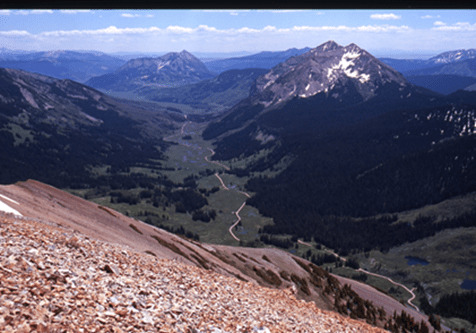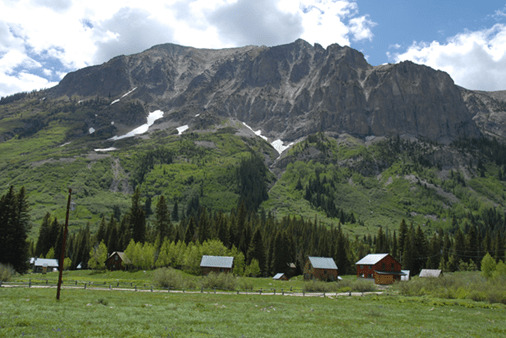Ever wondered what the words ‘sustainability’ and ‘sustainable’ really mean, especially in the context of whether or not humanity can or cannot be judged to be sustainable? Some say the words are overused, mis-used, outdated, no longer meaningful, and so on. To me, sustainability is a most useful word, possibly the most important word of all. I shall try to indicate this through a story, recounted below.
Like all good stories, mine begins a long time ago, in a land far away! Well it actually commences in 1972, which is not all that long ago. And it takes place in Colorado, USA, which is not really a distant land, especially if you live or visit there. Besides, I am happy to have an excuse to explain how I come to know Paul and Anne Ehrlich, and to show a few cool photos.
In 1972 I began to carry out research, on bumblebees, hummingbirds and the plants they visit, in the vicinity of the Rocky Mountain Biological Laboratory (hereafter RMBL), a field station located at about 3,000m elevation in the Colorado mountains. Here I met Paul and Anne, whom I have known ever since. I may describe some of the things we have done together in a future post. Right now my subject is really ‘sustainability’.
Through RMBL flows the East River, a river that is fed by snowmelt from nearby mountains, many of which get to 4,000m elevation and above. The area gets about 10m of snowfall per year, so there is plenty to melt as winter progresses to summer.
Just below RMBL, the river picks up steam. Here two drainage lines converge and the channel narrows. So the depth and rate of flow both pick up, especially in June, near the beginning of summer, when the rate of snowmelt is greatest.
A section of the river, starting at about this point, attracts people in kayaks who paddle downstream. A road, with a bridge  crossing the river, provides a convenient launch sites. From various subsequent exit points, it is possible to access a dirt road that returns to near the bridge. So people can drive to the river, kayaks typically on the roof, ride it downstream a ways, carry their kayaks back to their car, and repeat the adventure, or return home. Sounds like fun?
crossing the river, provides a convenient launch sites. From various subsequent exit points, it is possible to access a dirt road that returns to near the bridge. So people can drive to the river, kayaks typically on the roof, ride it downstream a ways, carry their kayaks back to their car, and repeat the adventure, or return home. Sounds like fun?
Well, actually there is a waterfall along this section of river that would make this adventure more exciting or terrifying, depending on your perspective. Over a short length of the river, it plunges about 30m, in three very steep sections, one immediately after the other. If you saw this waterfall (see photo) you could be forgiven for thinking that someone would have to be crazy or insane to attempt to go down it in a kayak, and it is no doubt for that reason that it is known, at least in the kayaking world, as ‘Stupid Falls’. But amazingly, that is exactly what some people do!
Click the image above for video of the kayaking
One day, I thought I would learn first-hand something about the kinds of people who engage in this particular form of ‘extreme’ sport and what the experience is like. I was walking along the dirt track not far from the falls, when I encountered three guys with wet-suits and helmets, and carrying kayaks. Seizing the opportunity, I inquired “Did you guys go down The Falls? What was it like?”
I was surprised by the answer I received, which was ‘No, we believe in sustainable kayaking!’
Feeling somewhat puzzled, I further inquired “What do you mean?”
In response to this, the same guy quickly said ‘It’s really pretty simple, sustainable kayaking is kayaking today so that we can still kayak tomorrow and the next day. That’s why we exited the river just above the falls!’
Then the proverbial penny dropped, and I realized exactly what ‘sustainability’ really means. It simply means “doing the things we do today, so that we can continue to do them tomorrow, and into the future”. If we include amongst the “things we do”, all our activities, including those that affect the environment, as well as our economics, society and health, and take the “we” to include ourselves, our kids, our grandkids, and subsequent generations, then we have a simple definition of sustainability for humanity.
What sustainability now means to me is therefore:
“Sustainability is doing (all) the things we do today, in ways such that we (including future generations) can continue to do them tomorrow, and into the future”.
By this definition, kayaking down Stupid Falls is probably not sustainable!
MAHB-UTS Blogs are a joint venture between the University of Technology Sydney and the Millennium Alliance for Humanity and the Biosphere. Questions should be directed to joan@mahbonline.org.
MAHB Blog: https://mahb.stanford.edu/blog/what-does-sustainability-really-mean/
The views and opinions expressed through the MAHB Website are those of the contributing authors and do not necessarily reflect an official position of the MAHB. The MAHB aims to share a range of perspectives and welcomes the discussions that they prompt.

